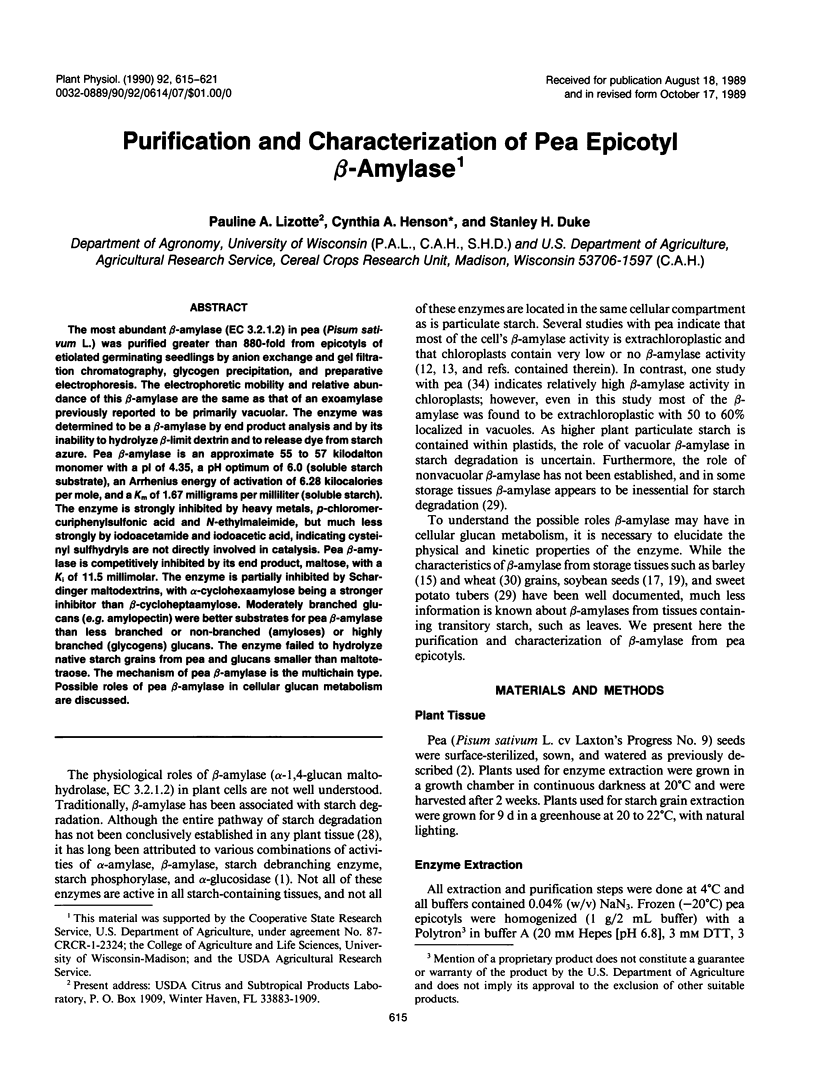Abstract
The most abundant β-amylase (EC 3.2.1.2) in pea (Pisum sativum L.) was purified greater than 880-fold from epicotyls of etiolated germinating seedlings by anion exchange and gel filtration chromatography, glycogen precipitation, and preparative electrophoresis. The electrophoretic mobility and relative abundance of this β-amylase are the same as that of an exoamylase previously reported to be primarily vacuolar. The enzyme was determined to be a β-amylase by end product analysis and by its inability to hydrolyze β-limit dextrin and to release dye from starch azure. Pea β-amylase is an approximate 55 to 57 kilodalton monomer with a pl of 4.35, a pH optimum of 6.0 (soluble starch substrate), an Arrhenius energy of activation of 6.28 kilocalories per mole, and a Km of 1.67 milligrams per milliliter (soluble starch). The enzyme is strongly inhibited by heavy metals, p-chloromer-curiphenylsulfonic acid and N-ethylmaleimide, but much less strongly by iodoacetamide and iodoacetic acid, indicating cysteinyl sulfhydryls are not directly involved in catalysis. Pea β-amylase is competitively inhibited by its end product, maltose, with a Ki of 11.5 millimolar. The enzyme is partially inhibited by Schardinger maltodextrins, with α-cyclohexaamylose being a stronger inhibitor than β-cycloheptaamylose. Moderately branched glucans (e.g. amylopectin) were better substrates for pea β-amylase than less branched or non-branched (amyloses) or highly branched (glycogens) glucans. The enzyme failed to hydrolyze native starch grains from pea and glucans smaller than maltotetraose. The mechanism of pea β-amylase is the multichain type. Possible roles of pea β-amylase in cellular glucan metabolism are discussed.
Full text
PDF






Images in this article
Selected References
These references are in PubMed. This may not be the complete list of references from this article.
- Beers E. P., Duke S. H. Localization of alpha-Amylase in the Apoplast of Pea (Pisum sativum L.) Stems. Plant Physiol. 1988 Aug;87(4):799–802. doi: 10.1104/pp.87.4.799. [DOI] [PMC free article] [PubMed] [Google Scholar]
- Bradford M. M. A rapid and sensitive method for the quantitation of microgram quantities of protein utilizing the principle of protein-dye binding. Anal Biochem. 1976 May 7;72:248–254. doi: 10.1016/0003-2697(76)90527-3. [DOI] [PubMed] [Google Scholar]
- Chang C. W. Isolation and purification of leaf starch components. Plant Physiol. 1979 Nov;64(5):833–836. doi: 10.1104/pp.64.5.833. [DOI] [PMC free article] [PubMed] [Google Scholar]
- Chapman G. W., Jr, Pallas J. E., Jr, Mendicino J. The hydrolysis of maltodextrins by a -amylase isolated from leaves of Vicia faba. Biochim Biophys Acta. 1972 Aug 28;276(2):491–507. doi: 10.1016/0005-2744(72)91010-8. [DOI] [PubMed] [Google Scholar]
- Doehlert D. C., Duke S. H., Anderson L. Beta-Amylases from Alfalfa (Medicago sativa L.) Roots. Plant Physiol. 1982 May;69(5):1096–1102. doi: 10.1104/pp.69.5.1096. [DOI] [PMC free article] [PubMed] [Google Scholar]
- Doehlert D. C., Duke S. H. Specific Determination of alpha-Amylase Activity in Crude Plant Extracts Containing beta-Amylase. Plant Physiol. 1983 Feb;71(2):229–234. doi: 10.1104/pp.71.2.229. [DOI] [PMC free article] [PubMed] [Google Scholar]
- Kakefuda G., Duke S. H. Characterization of Pea Chloroplast D-Enzyme (4-alpha-d-Glucanotransferase). Plant Physiol. 1989 Sep;91(1):136–143. doi: 10.1104/pp.91.1.136. [DOI] [PMC free article] [PubMed] [Google Scholar]
- Kakefuda G., Duke S. H. Electrophoretic transfer as a technique for the detection and identification of plant amylolytic enzymes in polyacrylamide gels. Plant Physiol. 1984 May;75(1):278–280. doi: 10.1104/pp.75.1.278. [DOI] [PMC free article] [PubMed] [Google Scholar]
- Laemmli U. K. Cleavage of structural proteins during the assembly of the head of bacteriophage T4. Nature. 1970 Aug 15;227(5259):680–685. doi: 10.1038/227680a0. [DOI] [PubMed] [Google Scholar]
- Marshall J. J. Inhibition of plant and bacterial beta-amylases. Mol Cell Biochem. 1975 May 30;7(2):127–129. doi: 10.1007/BF01792079. [DOI] [PubMed] [Google Scholar]
- Morita Y., Yagi F., Aibara S., Yamashita H. Chemical composition and properties of soybean beta-amylase. J Biochem. 1976 Mar;79(3):591–603. doi: 10.1093/oxfordjournals.jbchem.a131102. [DOI] [PubMed] [Google Scholar]
- Morrissey J. H. Silver stain for proteins in polyacrylamide gels: a modified procedure with enhanced uniform sensitivity. Anal Biochem. 1981 Nov 1;117(2):307–310. doi: 10.1016/0003-2697(81)90783-1. [DOI] [PubMed] [Google Scholar]
- Nebinger P. Separation and characterization of four different amylases of Entamoeba histolytica. I. Purification and properties. Biol Chem Hoppe Seyler. 1986 Mar;367(3):161–167. doi: 10.1515/bchm3.1986.367.1.161. [DOI] [PubMed] [Google Scholar]
- Nomura K., Mikami B., Morita Y. Interaction of soybean beta-amylase with glucose. J Biochem. 1986 Nov;100(5):1175–1183. doi: 10.1093/oxfordjournals.jbchem.a121821. [DOI] [PubMed] [Google Scholar]
- Shen G. J., Saha B. C., Lee Y. E., Bhatnagar L., Zeikus J. G. Purification and characterization of a novel thermostable beta-amylase from Clostridium thermosulphurogenes. Biochem J. 1988 Sep 15;254(3):835–840. doi: 10.1042/bj2540835. [DOI] [PMC free article] [PubMed] [Google Scholar]
- Silvanovich M. P., Hill R. D. Affinity chromatography of cereal alpha-amylase. Anal Biochem. 1976 Jun;73(2):430–433. doi: 10.1016/0003-2697(76)90191-3. [DOI] [PubMed] [Google Scholar]
- Subbaramaiah K., Sharma R. Affinity chromatography of mustard beta-amylase on starch columns. J Biochem Biophys Methods. 1985 Mar;10(5-6):315–320. doi: 10.1016/0165-022x(85)90066-1. [DOI] [PubMed] [Google Scholar]
- Trimble R. B., Maley F. Optimizing hydrolysis of N-linked high-mannose oligosaccharides by endo-beta-N-acetylglucosaminidase H. Anal Biochem. 1984 Sep;141(2):515–522. doi: 10.1016/0003-2697(84)90080-0. [DOI] [PubMed] [Google Scholar]
- Vretblad P. Immobilization of ligands for biospecific affinity chromatography via their hydroxyl groups. The cyclohexaamylose-beta-amylase system. FEBS Lett. 1974 Oct 1;47(1):86–89. doi: 10.1016/0014-5793(74)80431-x. [DOI] [PubMed] [Google Scholar]
- Ziegler P., Beck E. Exoamylase activity in vacuoles isolated from pea and wheat leaf protoplasts. Plant Physiol. 1986 Dec;82(4):1119–1121. doi: 10.1104/pp.82.4.1119. [DOI] [PMC free article] [PubMed] [Google Scholar]





